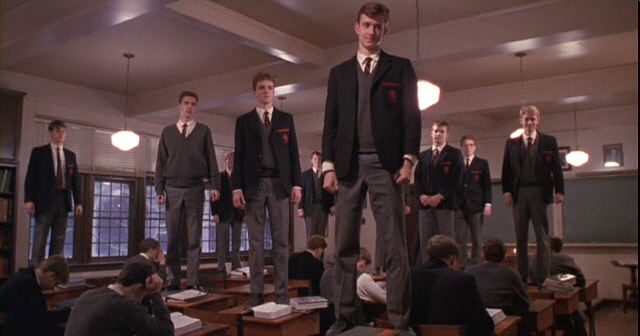Should You Send Your Kid To A Same-Sex School?
For my part, I don’t think I’d be the vocal and public feminist that I am today were it not for single-sex education.
By ![]() Chloe Angyal
Chloe Angyal

I was dragged kicking and screaming to all-girls school. I was 11, I was boy-crazy, and the idea of spending the next six years of my life without any guys around made me want to sob. Which I did, in the hopes that it would convince my parents to send me to a co-ed school.
I tried everything I could think of to reason with them. I spend all my afternoons at gymnastics practice, where there are also no boys, I reminded them. Isn’t that enough all-girls time? I concentrate better with boys around, because I want to beat them, I lied through my teeth. Don’t you want me to be motivated by an 11-year-old’s misguided conception of what feminism is? The real world has boys and girls, I argued. Don’t you want me to learn how to live in the real world? (That I imagined they would buy my line about concentrating harder with boys around suggests that I was already not living in the real world).
My arguments fell on deaf ears. They sent me to a private all-girls Anglican school in Sydney, Australia — a really good school, for which I should have been, and eventually was, damn grateful. I emerged six years later still boy crazy, but now also a raging feminist (contrary to popular belief, the two are not mutually exclusive). I had played on an all-girls sports team, competed against boys’ schools in an all-girls debating team, and performed in an almost-all-girls production of The Pirates of Penzance (at one point, the girls who wound up cast as pirates had a long and in retrospect incredibly ill-informed discussion about whether our characters were effeminate men pirates or butch women pirates. We never came to a consensus, which is just one reason why that show was, shall we say, not Tony material). It took me almost the full six years to understand that maybe my parents had been right, and that single sex education had been a good route for me. After six years, I left that place ready to go off to university, though only one of the ten schools I applied to was a women’s college; I figured that it really was now time to experience the real world, where boys and girls are thrown together (college, of course, is also not the real world, because in the real world, you can’t show up to Friday morning meetings reeking of Thursday night’s stale “beer” — which is what they call Natty Lite in college, a further piece of evidence that it is not the real world). I found myself more or less equipped for college (my liver needed some remedial classes and my trend of being utterly useless at maths, which had started way back in fifth grade, continued). It was far from perfect — more on that later — but single sex education served me pretty well, and better, I suspect, than co-ed school would have.
Statistically speaking, that shouldn’t be true. According to a new study, there is no discernible difference between the educational attainments of girls who go to co-ed schools and those who go to all-girls schools. The study found that “students who attended single-sex schools weren’t any better off than peers who attended coed programs in terms of self-esteem or performance in STEM (science, technology, engineering and math) subjects.” That goes for boys, too.
But as one report on the findings noted, though study after study indicates that single-sex education has no tangible benefits, and even that it can be detrimental, lots of people who went to single-sex schools — myself included — credit the experience with molding them into the kind of people they’re proud to be. Women, especially, argue that all-girls school gave them the space to become the feminists they are today. That’s certainly what I argue, even though I know what the studies show. This is not to say that there aren’t people who hated single-sex school, but clearly, lots of people perceive the experience as having been a beneficial one, even though, scientifically speaking, it isn’t.
For my part, I don’t think I’d be the vocal and public feminist that I am today were it not for single-sex education. Though I was raised by two feminist parents, it was at school that I was most memorably exposed to feminist ideas in writing, or in a classroom setting. In English class, during a unit on fairy tales, we read The Bloody Chamber, Angela Carter’s feminist re-working of classic stories. A substitute teacher went off-script and gave a long and impassioned lecture about how language privileges masculinity — the word “motherfucker” was said a lot, to our shock and delight. In drama class, after some serious negotiation with my teacher, I was allowed to perform an excerpt from The Vagina Monologues, one that involved faking an orgasm on stage (oh my god, my poor, poor parents. Serves them right for sending me to an all-girls school). Though the absence of guys didn’t stop us from thinking or talking about guys a lot — we were teenagers, and all-girls schools aren’t magical — it did allow us to talk about being girls a lot. In the Year 12 common room, in sex ed classes, in home room, we had the space to talk about the experience of being girls, in frank and honest terms that we probably wouldn’t have felt comfortable with had there been guys in the room.
It wasn’t all roses, of course, and sometimes I marvel that I managed to become a feminist at all, given how much time I spent trying to tear other women down – and having them do the same to me. I spent several years at that school engaged in the kind of girl-fighting you usually dismiss as exaggerated and unrealistic when you see it in teen movies. Those stereotypes about all-girls schools being hubs of girl-on-girl bitchiness and feuding weren’t, in our case, totally baseless (see also: eating disorders). We were awful to each other. And as I told Al Jazeera earlier this week, just because there weren’t guys in the room didn’t mean there weren’t guys in the room. We fought for their attention just as we would had they physically been there – we just did it via text, IM, and at weekend parties, where we had to figure out how the hell to socialize with these alien creatures after spending the last five days running our mouths about tampons and our collective crush on Paul Walker.
Most of us turned out alright in the end. Statistically speaking, it shouldn’t have made any difference; we would have been just as social adept (or inept) had we been at a co-ed school. And the studies suggest that the presence of guys in my classroom wouldn’t have changed the fact that I am, and always have been, dreadful at maths. And yet, most of us feel like it made a difference for us, whether we hated single-sex school or are grateful for it.
It’s hard to look at the studies without concluding that we ought to do away with single-sex schools. It’s even harder to square that reality with my personal experience, and that of so many others who believe that they wouldn’t be the people they are without single-sex education. Then again, they taught me well at that place: the plural of anecdote is not data. Representative and replicable studies are more reliable than our own fond remembrances. My father always said that he wanted me to go to an all-girls school because, when he was in high school, his debate team went up against a team from an all-girls school, and he was struck by how terribly articulate and intimidatingly “together” those girls were. At 11, when I was trying to argue my way out of six years in a boy-barren wasteland, I didn’t yet have the experience to suspect that maybe, when you’re a dorky fifteen-year-old boy, all young women are intimidating.
So on one hand, you have memories, tradition, and personal experience. On the other hand, you have hard data. If our single-sex schools really did educate us as well as we claim they did, then it should be quite obvious to us which form of evidence is the more valid — and which one should be guiding our policy and our personal parenting choices. ![]()




